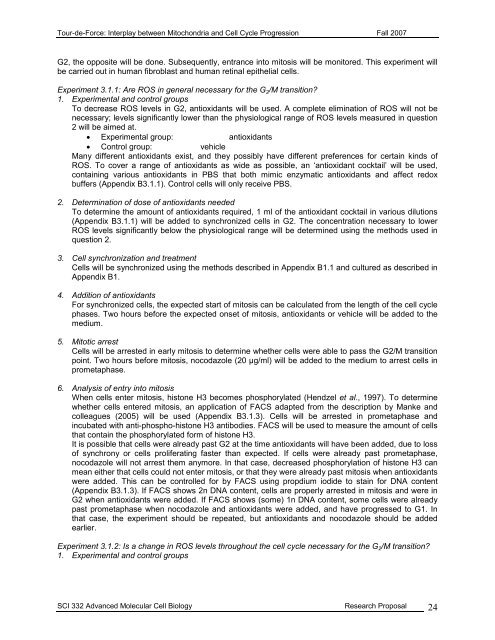Tour-de-Force
Tour-de-Force
Tour-de-Force
Create successful ePaper yourself
Turn your PDF publications into a flip-book with our unique Google optimized e-Paper software.
<strong>Tour</strong>-<strong>de</strong>-<strong>Force</strong>: Interplay between Mitochondria and Cell Cycle Progression Fall 2007G2, the opposite will be done. Subsequently, entrance into mitosis will be monitored. This experiment willbe carried out in human fibroblast and human retinal epithelial cells.Experiment 3.1.1: Are ROS in general necessary for the G 2 /M transition?1. Experimental and control groupsTo <strong>de</strong>crease ROS levels in G2, antioxidants will be used. A complete elimination of ROS will not benecessary; levels significantly lower than the physiological range of ROS levels measured in question2 will be aimed at.• Experimental group: antioxidants• Control group: vehicleMany different antioxidants exist, and they possibly have different preferences for certain kinds ofROS. To cover a range of antioxidants as wi<strong>de</strong> as possible, an ‘antioxidant cocktail’ will be used,containing various antioxidants in PBS that both mimic enzymatic antioxidants and affect redoxbuffers (Appendix B3.1.1). Control cells will only receive PBS.2. Determination of dose of antioxidants nee<strong>de</strong>dTo <strong>de</strong>termine the amount of antioxidants required, 1 ml of the antioxidant cocktail in various dilutions(Appendix B3.1.1) will be ad<strong>de</strong>d to synchronized cells in G2. The concentration necessary to lowerROS levels significantly below the physiological range will be <strong>de</strong>termined using the methods used inquestion 2.3. Cell synchronization and treatmentCells will be synchronized using the methods <strong>de</strong>scribed in Appendix B1.1 and cultured as <strong>de</strong>scribed inAppendix B1.4. Addition of antioxidantsFor synchronized cells, the expected start of mitosis can be calculated from the length of the cell cyclephases. Two hours before the expected onset of mitosis, antioxidants or vehicle will be ad<strong>de</strong>d to themedium.5. Mitotic arrestCells will be arrested in early mitosis to <strong>de</strong>termine whether cells were able to pass the G2/M transitionpoint. Two hours before mitosis, nocodazole (20 µg/ml) will be ad<strong>de</strong>d to the medium to arrest cells inprometaphase.6. Analysis of entry into mitosisWhen cells enter mitosis, histone H3 becomes phosphorylated (Hendzel et al., 1997). To <strong>de</strong>terminewhether cells entered mitosis, an application of FACS adapted from the <strong>de</strong>scription by Manke andcolleagues (2005) will be used (Appendix B3.1.3). Cells will be arrested in prometaphase andincubated with anti-phospho-histone H3 antibodies. FACS will be used to measure the amount of cellsthat contain the phosphorylated form of histone H3.It is possible that cells were already past G2 at the time antioxidants will have been ad<strong>de</strong>d, due to lossof synchrony or cells proliferating faster than expected. If cells were already past prometaphase,nocodazole will not arrest them anymore. In that case, <strong>de</strong>creased phosphorylation of histone H3 canmean either that cells could not enter mitosis, or that they were already past mitosis when antioxidantswere ad<strong>de</strong>d. This can be controlled for by FACS using propdium iodi<strong>de</strong> to stain for DNA content(Appendix B3.1.3). If FACS shows 2n DNA content, cells are properly arrested in mitosis and were inG2 when antioxidants were ad<strong>de</strong>d. If FACS shows (some) 1n DNA content, some cells were alreadypast prometaphase when nocodazole and antioxidants were ad<strong>de</strong>d, and have progressed to G1. Inthat case, the experiment should be repeated, but antioxidants and nocodazole should be ad<strong>de</strong><strong>de</strong>arlier.Experiment 3.1.2: Is a change in ROS levels throughout the cell cycle necessary for the G 2 /M transition?1. Experimental and control groupsSCI 332 Advanced Molecular Cell Biology Research Proposal 24
















